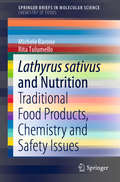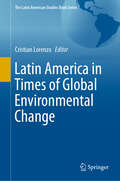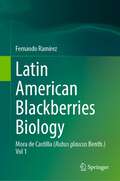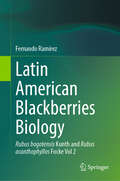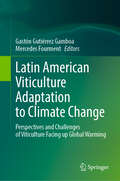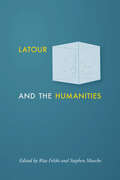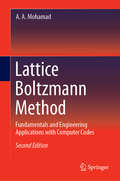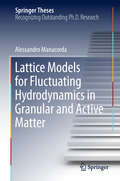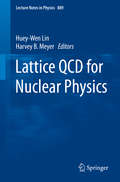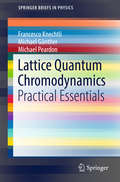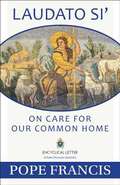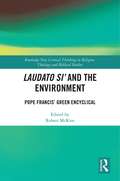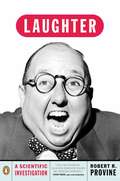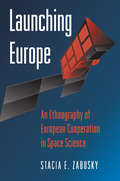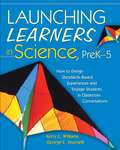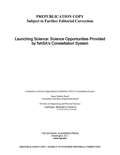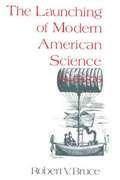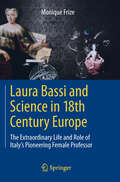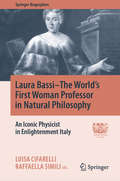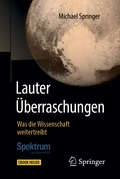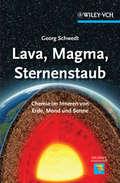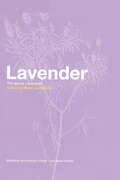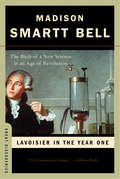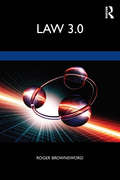- Table View
- List View
Lathyrus sativus and Nutrition: Traditional Food Products, Chemistry and Safety Issues (SpringerBriefs in Molecular Science)
by Michele Barone Rita TulumelloThis book addresses the traditional use of a specific crop legume, grass pea (Lathyrus sativus), as a food product and ingredient for typical food products. Grass pea has very interesting nutritional qualities, including an abundance of proteins and peculiar organoleptic properties. As the crop also shows an enhanced resistance to adverse conditions, it is used in many geographical areas as the main ingredient of certain traditional foods. On the other hand, grass pea is questionable as a source of human and animal nutrition because it contains a neurotoxin – β-N-oxalyl-L-α,β-diaminopropionic acid – that is known for its neurological effects. The related disease is referred to as ‘neurolathyrism’ and occurs when grass pea-based foods are consumed in large quantities. The book is divided into five chapters, the first of which summarizes the chemical and biochemical properties of grass pea and provides nutritional evaluations. The second chapter provides an overview of foods containing Lathyrus sativus around the world, while the third describes Italian foods in detail. The fourth chapter focuses on the problem of neurolathyrism in connection with human nutrition and health. In closing, the fifth chapter sheds light on the historical and traditional food products sector from a food traceability and authenticity standpoint.
Latin America in Times of Global Environmental Change (The Latin American Studies Book Series)
by Cristian LorenzoThis volume discusses the challenges of Latin America in global environmental geopolitics. Written by leading experts, this book brings together Latin American research on global environmental change. They cover a range of topics such as climate change, water, forest and biodiversity conservation connected with science policies, public opinion, priorities of international funds, and international politics of Latin American countries. The book describes the discrepancy between the international priorities and the regional needs or country interests. It includes several case studies and analyses the cooperation in multilateral negotiations on climate change. It also offers a synthesis of debates around global environmental changes and Latin American politics, which the authors have previously promoted in different academic events in South America, including in Santiago de Chile in Chile, and Buenos Aires and Ushuaia in Argentina.This book assesses the environmental problems from different perspectives, highlights the scientific development in the environmental changes affecting Latin America and offers a new view on geopolitics to help face those issues. Specialist readers in international relations, political sciences, environmental sciences, geography and geopolitics will appreciate this up-to-date examination of Latin America and the global environmental change.
Latin American Blackberries Biology: Mora de Castilla (Rubus glaucus Benth.) Vol 1
by Fernando RamírezThe current book focuses on Mora de Castilla (Rubus glaucus Benth.). It explores aspects, such as origin, phenology, propagation, floral and fruit morphology, arthropod visitors, pollination mechanisms, propagation methods, chromosome number, fruit development, breeding, morphological diversity, and the impact of climate change. It includes novel data about plant phenology, flowering, insect visitors, seed germination, fruit morphology, and allometric relationships. This work includes an in-depth review of the most recently published information on the topic. Mora de Castilla is an economically important fruit crop from the Andes. It has been crossed with other Rubus species due to its high yield and everbearing habit. Currently, it is an economically important plant. It has been hybridized with other Rubus species producing new and better-quality hybrids This book contains numerous photographs selected by the author to provide the reader with detailed information about the plant´s morphological features and arthropod visitors.
Latin American Blackberries Biology: Rubus bogotensis Kunth and Rubus acanthophyllos Focke Vol 2
by Fernando RamírezThis book explores two Rubus species from South America. It will address the species Rubus bogotensis Kunth and Rubus acanthophyllos Focke. It addresses aspects, such as origin, phenology, propagation, floral and fruit morphology, arthropod visitors, pollination, breeding, morphological diversity, and genetic diversity. It includes new unpublished data and results about plant phenology, flowering, insect visitors, fruit length-weight relationships, and fruit and pyrene morphology. This work includes an in-depth review of the most recently published information on the topic. The Rubus species studies are underutilized crops from Latin America. Furthermore, these species could be used in breeding programs for improvement. They can also be hybridized with other Rubus species to obtain better-quality hybrids. This book contains numerous photographs selected by the author to provide the reader with detailed information about the plant´s morphological features and arthropod visitors.
Latin American Viticulture Adaptation to Climate Change: Perspectives and Challenges of Viticulture Facing up Global Warming
by Gastón Gutiérrez Gamboa Mercedes FourmentLatin American viticulture faces a wide range of difficulties that include social, political, economic, and productive aspects. Soil diversity, together with the climates in which the viticulture activity takes place, favours the production of grapes, juices, raisins, musts, wines, and distillates with unique and distinctive characters for the world. In addition, the great genetic diversity that covers autochthonous and minor grapevine varieties, including unknown genotypes, opens a wide range of research opportunities for the adaptation of the viticulture to the negative effects of global warming, favouring sustainability and social equity. This book compiles the research about the new viticultural trends performed in diverse regions from Latin America such as Argentina, Brazil, Bolivia, Chile, Dominican Republic, Haiti and Uruguay, covering different topics in viticulture of global importance. This book addresses the impacts of soil and climatic conditions and viticultural practices on vine physiology, berry quality and wine typicity, including topics related to social sciences and agricultural economics. This will allow to provide a relevant discussion for future guidelines in viticulture under a territorial development perspective.
Latour and the Humanities
by Rita Felski and Stephen MueckeHow does the work of influential theorist Bruno Latour offer a fresh angle on the practices and purposes of the humanities?In recent years, defenses of the humanities have tended to argue along predictable lines: the humanities foster empathy, the humanities encourage critical thinking, the humanities offer a counterweight to the cold calculations of the natural and social sciences. The essays in Latour and the Humanities take a different approach. Exploring the relevance of theorist Bruno Latour's work, they argue for attachments and entanglements between the humanities and the sciences while looking closely at the interests, institutions, and intellectual projects that shape the humanities within and beyond the university. The collection, which is written by a group of highly distinguished scholars from around the world, is divided into two sections. In the first part, authors engage in depth with Latour's work while also rethinking the ties between the humanities and the sciences. Essays argue for greater attention to the nonhuman world, the urgency of climate change, and more nuanced views of universities as institutions. The second half of the volume contains essays that reflect on Latour's influence on the practices of specific disciplines, including art, the digital humanities, film studies, and political theory.Inspiring conversation about the relevance of actor-network-theory for research and teaching in the humanities, Latour and the Humanities offers a substantial introduction to Latour's work while discussing the humanities without falling back on the genres of either the sermon or the jeremiad. This volume will be of interest to all those searching for fresh perspectives on the value and importance of humanistic disciplines and thought.Contributors: David J. Alworth, Anders Blok, Claudia Breger, Dipesh Chakrabarty, Yves Citton, Steven Connor, Gerard de Vries, Simon During, Rita Felski, Francis Halsall, Graham Harman, Antoine Hennion, Casper Bruun Jensen, Bruno Latour, Heather Love, Patrice Maniglier, Stephen Muecke, Barbara Herrnstein Smith, Nigel Thrift, Michael Witmore
Lattice Boltzmann Method
by A. A. MohamadLattice Boltzmann Method introduces the lattice Boltzmann method (LBM) for solving transport phenomena - flow, heat and mass transfer - in a systematic way. Providing explanatory computer codes throughout the book, the author guides readers through many practical examples, such as: flow in isothermal and non-isothermal lid driven cavities;flow over obstacles;forced flow through a heated channel;conjugate forced convection; andnatural convection.Diffusion and advection-diffusion equations are discussed with applications and examples, and complete computer codes accompany the coverage of single and multi-relaxation-time methods. Although the codes are written in FORTRAN, they can be easily translated to other languages, such as C++. The codes can also be extended with little effort to multi-phase and multi-physics, if the reader knows the physics of the problem. Readers with some experience of advanced mathematics and physics will find Lattice Boltzmann Method a useful and easy-to-follow text. It has been written for those who are interested in learning and applying the LBM to engineering and industrial problems and it can also serve as a textbook for advanced undergraduate or graduate students who are studying computational transport phenomena.
Lattice Boltzmann Method: Fundamentals and Engineering Applications with Computer Codes
by A. A. MohamadThis book introduces readers to the lattice Boltzmann method (LBM) for solving transport phenomena – flow, heat and mass transfer – in a systematic way. Providing explanatory computer codes throughout the book, the author guides readers through many practical examples, such as:• flow in isothermal and non-isothermal lid-driven cavities;• flow over obstacles;• forced flow through a heated channel;• conjugate forced convection; and• natural convection.Diffusion and advection–diffusion equations are discussed, together with applications and examples, and complete computer codes accompany the sections on single and multi-relaxation-time methods. The codes are written in MatLab. However, the codes are written in a way that can be easily converted to other languages, such as FORTRANm Python, Julia, etc. The codes can also be extended with little effort to multi-phase and multi-physics, provided the physics of the respective problem are known.The second edition of this book adds new chapters, and includes new theory and applications. It discusses a wealth of practical examples, and explains LBM in connection with various engineering topics, especially the transport of mass, momentum, energy and molecular species.This book offers a useful and easy-to-follow guide for readers with some prior experience with advanced mathematics and physics, and will be of interest to all researchers and other readers who wish to learn how to apply LBM to engineering and industrial problems. It can also be used as a textbook for advanced undergraduate or graduate courses on computational transport phenomena
Lattice Models for Fluctuating Hydrodynamics in Granular and Active Matter (Springer Theses)
by Alessandro ManacordaThis book investigates the common nature of granular and active systems, which is rooted in their intrinsic out-of-equilibrium behavior, with the aim of finding minimal models able to reproduce and predict the complex collective behavior observed in experiments and simulations. Granular and active matter are among the most studied systems in out-of-equilibrium statistical physics. The book guides readers through the derivation of a fluctuating hydrodynamic description of granular and active matter by means of controlled and transparent mathematical assumptions made on a lattice model. It also shows how a macroscopic description can be provided from microscopic requirements, leading to the prediction of collective states such as cooling, swarming, clustering and the transitions among them. The analytical and numerical results shed new light on the physical connection between the local, microscopic properties of few particles and the macroscopic collective motion of the whole system.
Lattice QCD for Nuclear Physics
by Huey-Wen Lin Harvey B. MeyerWith ever increasing computational resources and improvements in algorithms, new opportunities are emerging for lattice gauge theory to address key questions in strongly interacting systems, such as nuclear matter. Calculations today use dynamical gauge-field ensembles with degenerate light up/down quarks and the strange quark and it is possible now to consider including charm-quark degrees of freedom in the QCD vacuum. Pion masses and other sources of systematic error, such as finite-volume and discretization effects, are beginning to be quantified systematically. Altogether, an era of precision calculation has begun and many new observables will be calculated at the new computational facilities. The aim of this set of lectures is to provide graduate students with a grounding in the application of lattice gauge theory methods to strongly interacting systems and in particular to nuclear physics. A wide variety of topics are covered, including continuum field theory, lattice discretizations, hadron spectroscopy and structure, many-body systems, together with more topical lectures in nuclear physics aimed a providing a broad phenomenological background. Exercises to encourage hands-on experience with parallel computing and data analysis are included.
Lattice Quantum Chromodynamics
by Michael Günther Francesco Knechtli Michael PeardonThis book provides an overview of the techniques central to lattice quantum chromodynamics, including modern developments. The book has four chapters. The first chapter explains the formulation of quarks and gluons on a Euclidean lattice. The second chapter introduces Monte Carlo methods and details the numerical algorithms to simulate lattice gauge fields. Chapter three explains the mathematical and numerical techniques needed to study quark fields and the computation of quark propagators. The fourth chapter is devoted to the physical observables constructed from lattice fields and explains how to measure them in simulations. The book is aimed at enabling graduate students who are new to the field to carry out explicitly the first steps and prepare them for research in lattice QCD.
Laudato Si: On Care for Our Common Home
by Pope Francis<p><i>In the heart of this world, the Lord of life, who loves us so much, is always present. He does not abandon us, he does not leave us alone, for he has united himself definitively to our earth, and his love constantly impels us to find new ways forward. Praise be to him!</i> Pope Francis, <i>Laudato Si</i> <p>In his second encyclical, <i>Laudato Si: On Care of Our Common Home</i>, Pope Francis draws all Christians into a dialogue with every person on the planet about our common home. We as human beings are united by the concern for our planet, and every living thing that dwells on it, especially the poorest and most vulnerable. Pope Francis letter joins the body of the Church's social and moral teaching, draws on the best scientific research, providing the foundation for the ethical and spiritual itinerary that follows. <i>Laudato Si</i> outlines: <p> <li>The current state of our common home <li>The Gospel message as seen through creation <li>The human causes of the ecological crisis <li>Ecology and the common good <li>Pope Francis' call to action for each of us</li> <p> <p>Our Sunday Visitor has included discussion questions, making it perfect for individual or group study, leading all Catholics and Christians into a deeper understanding of the importance of this teaching.
Laudato Si’ and the Environment: Pope Francis’ Green Encyclical (Routledge New Critical Thinking in Religion, Theology and Biblical Studies)
by Robert McKimThis volume is a response to the Pope’s Laudato Si’, giving an interdisciplinary overview of its impact on the environmental concerns of Catholics as well as other religious groups. Published in 2015, it is often seen as an "environmental" encyclical and in it the Pope urges us to face up to the crisis of climate change. He argues that all of us should prioritise taking better care of the Earth, our common home, while also attending to the plight of the poor. Written by an international and multidisciplinary team of leading scholars, the Pope’s invitation to all people to begin a new dialog about these matters is considered from a variety of perspectives. There is discussion of the implications for immigration, population control, eating animals, and property ownership. Additionally, indigenous religious perspectives, development and environmental protection, and the implementation of the ideas of the encyclical in the Church are explored. Each chapter deals with the scriptural, theological, and philosophical underpinnings of the encyclical, as well as other central concepts such as interconnectedness, the role of practice, and what Pope Francis calls the "technocratic paradigm". This book expertly illuminates the relationship between Laudato Si’ and environmental concerns. It will, therefore, be vital reading for anyone studying religion and the environment, environmental ethics, Catholic theology, and environmental thought.
Laughter: A Scientific Investigation
by Robert R. ProvineWhy do we laugh? Laughter has surprisingly little to do with jokes and funny stories. It is an ancient, unconsciously controlled vocal relic that co-exists with our relatively modern speech - a social, psychological and biological act which predates humour and is sharedwith our primate cousins, the great apes. In this fascinating book Robert Provine uses laughter as a powerful probe into human social relationships, revealing that tickling is a form of tactilecommunication, not a reflex; that women laugh more at men than vice-versa; that speakers laugh more than their audiences; and that laughter is mostly about relationships, not jokes. Using the latest evidence, Provine describes laughter using sonic analysis and opera scores, evaluates whether you can 'laugh you way to health', considers what laughter shows about neuropathology, and suggests how to change environments to increase laughter. The first book to establish laughter as a topic of scientific worth, Laughter also includes such esoterica as the history of holy laughter, laughing gas, canned laughter, and a description of the Tanganyikan laughter epidemic that immobilized an entire school district in 1962.
Launching Europe: An Ethnography of European Cooperation in Space Science
by Stacia E. ZabuskyIn this first ethnographic study of the European Space Agency, Stacia Zabusky explores the complex processes involved in cooperation on space science missions in the contemporary context of European integration. Zabusky argues that the practice of cooperation does not depend on a homogenizing of interests in a bland unity. Instead, it consists of ongoing negotiation of and conflict over often irreconcilable differences. In this case, those differences are put into play by both technical and political divisions of labor (in particular, those of big science and of European integration). Zabusky shows how participants on space science missions make use of these differences, particularly those manifest in identities of work and of nationality, as they struggle together not only to produce space satellites but also to create European integration. She argues that the dialectical processes of production include and depend on conflict and contradiction to maintain energy and excitement and thus to be successful. Participants in these processes are not, however, working only to produce tangible success. In her epilogue, Zabusky argues that European space science missions can be interpreted as sacred journeys undertaken collectively, and that these journeys are part of a fundamental cultural project of modernity: the legitimation of and aspiration for purity. She suggests, finally, that this project characterizes not only the institution of technoscience but those of bureaucracy and nationalism as well.
Launching Learners in Science, PreK5: How to Design Standards-Based Experiences and Engage Students in Classroom Conversations
by Kerry C. Williams George E. VeomettThe only way to teach science is to do science. The combination of teaching and doing involves three elements: knowing content, teachers knowing and understanding themselves as teachers and learners, and, most importantly, knowing children. Kerry C. Williams and George E. Veomett describe principles and requirements that reflect the National Science Education Standards for the active learning of science. They brilliantly identify key ingredients for primary students and outline the best course of action to aid their development as young scientists.Using research on cognitive and neural development and motivational theory from the work of Piaget and Vygotsky, this is an invaluable tool for teachers inexperienced in science. It will help you discover new ways to think about science and develop lessons that are rich, fun, and authentic for both you and your students.All educators will find examples, questions, stories, and thought-provoking ideas to give students a strong start in science achievement, plus: Six key elements to build into science instruction: observing, representing, organizing, patterning and questioning, experimenting, and sharing How-to's for incorporating inquiry, workshops, centers, and projects in primary and elementary classrooms A four-step system-choice, planning, doing, reviewing-that helps promote learning in science and across all subjects
Launching Science: Science Opportunities Provided by NASA's Constellation System
by National Research Council of the National AcademiesIn January 2004 NASA was given a new policy direction known as the Vision for Space Exploration. That plan, now renamed the United States Space Exploration Policy, called for sending human and robotic missions to the Moon, Mars, and beyond. In 2005 NASA outlined how to conduct the first steps in implementing this policy and began the development of a new human-carrying spacecraft known as Orion, the lunar lander known as Altair, and the launch vehicles Ares I and Ares V. Collectively, these are called the Constellation System. In November 2007 NASA asked the National Research Council (NRC) to evaluate the potential for new science opportunities enabled by the Constellation System of rockets and spacecraft. The NRC committee evaluated a total of 17 mission concepts for future space science missions. Of those, the committee determined that 12 would benefit from the Constellation System and five would not. This book presents the committee's findings and recommendations, including cost estimates, a review of the technical feasibility of each mission, and identification of the missions most deserving of future study.
Laura Bassi and Science in 18th Century Europe: The Extraordinary Life and Role of Italy's Pioneering Female Professor
by Monique FrizeThis book presents the extraordinary story of a Bolognese woman of the settecento. Laura Maria Caterina Bassi (1711-1778) defended 49 Theses at the University of Bologna on April 17, 1732 and was awarded a doctoral degree on May 12 of the same year. Three weeks before her defense, she was made a member of the Academy of Sciences in Bologna. On June 27 she defended 12 additional Theses. Several of the 61 Theses were on physics and other science topics. Laura was drawn by the philosophy of Newton at a time when most scientists in Europe were still focused on Descartes and Galen. This last set of Theses was to encourage the University of Bologna to provide a lectureship to Laura, which they did on October 29, 1732. Although quite famous in her day, Laura Bassi is unfortunately not remembered much today. This book presents Bassi within the context of the century when she lived and worked, an era where no women could attend university anywhere in the world, and even less become a professor or a member of an academy. Laura was appointed to the Chair of experimental physics in 1776 until her death. Her story is an amazing one. Laura was a mother, a wife and a good scientist for over 30 years. She made the transition from the old science to the new very early on in her career. Her work was centered on real problems that the City of Bologna needed to solve. It was an exciting time of discovery and she was at the edge of it all the way.
Laura Bassi–The World's First Woman Professor in Natural Philosophy: An Iconic Physicist in Enlightenment Italy (Springer Biographies)
by Luisa Cifarelli Raffaella SimiliThis book provides a fascinating insight into the life and scientific work of Laura Bassi, the first female member of the influential Academy of Sciences of the Institute of Bologna and also the first woman to be appointed a university professor in physics, or universal philosophy as it was then termed. The book describes Laura Bassi’s research activities and achievements, explaining the influence of Newton, her role in promoting Newtonian experimental physics in Bologna, and her work as an experimentalist, including on electricity. Much attention is paid to the context in which Bassi developed her career. The very considerable difficulties faced by a woman surrounded by male university teachers and members of the Academy are discussed, casting light on the constraints that led Bassi to set up the first experimental physics laboratory in her home, complete with the many instruments required for experimentation and private teaching. The aim is to provide a rounded and well-documented account of the scientific endeavors and achievements of a too often overlooked scientist who struggled to overcome the prejudices of her age.
Lauter Überraschungen: Was die Wissenschaft weitertreibt
by Michael Springer„Springers Einwürfe“ – kritisch-amüsante Begleitungen des Forschungsbetriebs Nach Unendliche Neugier. Was die Wissenschaft treibt zeichnet eine weitere Auswahl aus "Springers Einwürfe" ab 2011 zusammen mit zwei längeren Essays ein buntes, abwechslungsreiches Bild des aktuellen Wissenschaftsbetriebs, seiner Resultate und Probleme. So entsteht ein laufender Kommentar, der einzelwissenschaftliche Erkenntnisse beschreibt, erklärt und in einen gesellschaftlichen Rahmen stellt. Im Vordergrund steht die Relevanz dieser und jener Entdeckung für die allgemeine Kultur: Schafft die Hirnforschung den freien Willen ab? Welche Wirklichkeit beschreibt die Quantenphysik? Werden Computer einmal Bewusstsein entwickeln? Durch die essayistische, anekdotische Form der größtenteils kurzen Beiträge ist Lesevergnügen garantiert.
Lava, Magma, Sternenstaub: Chemie im Inneren von Erde, Mond und Sonne (Erlebnis Wissenschaft)
by Georg SchwedtMehr als 9000 Meter tief im Erdinneren Genau 9101 Meter schaffte der Tiefbohrer in Windischeschenbach, dann versagte er aufgrund der großen Hitze von mehr als 300 Grad. Welche Schichten im Erdinneren stecken und wie diese beschaffen sind, das analysiert Georg Schwedt hier höchst anschaulich. Er reist entlang der „Deutschen Vulkanstraße“, und ganz nebenbei erfahren die Leser zum Beispiel, dass sie sich bei einer Hornhautbehandlung mit Bims die Füße mit dem Vulkangestein Magma schrubben. Unendliche Weiten oder die Chemie der Planeten Wie setzt sich der Schweif eines Kometen zusammen oder welche chemischen Bestandteile finden sich auf Sonne und Mond? Die Chemie der Planeten ist zwar schwer zu erforschen, aber dafür spannend und faszinierend – ranken sich doch um Venus, Saturn oder Mars Mythen aus alter Zeit und verbanden doch schon die Babylonier die Venus, den hellsten Wandelstern, mit den Göttinnen. Aristoteles und Galileo Galilei: Wie alles anfing Dieses Buch bietet die neusten Erkenntnisse über Erde und Universum, gleichzeitig aber auch einen sehr unterhaltsamen Rückblick auf die Anfänge der Wissenschaftsgeschichte. Von Aristoteles, der um 334 v. Chr. eine Theorie über die Kugelgestalt der Erde entwickelte, bis zu Galileo Galilei, der 1616 wegen seines Eintretens für das heliozentrische Weltbild von der Inquisition angeklagt wurde, entsteht hier ein buntes, spannendes Bild, das große Lust auf Wissenschaft macht.
Lavender: The Genus Lavandula (Medicinal and Aromatic Plants - Industrial Profiles)
by Maria Lis-BalchinLavandula species are mainly grown for their essential oils, which are used in perfumery, cosmetics, food processing and aromatherapy products, and for their use as ornamental plants and ingredients in numerous cottage industry products. Certain types of lavender oil have also been shown to have antimicrobial and antifungal properties. The dried fl
Lavoisier in the Year One: The Birth of a New Science in an Age of Revolution (Great Discoveries)
by Madison Smartt Bell"Fresh . . . solid . . . full of suspense and intrigue."--Publishers Weekly Antoine Lavoisier reinvented chemistry, overthrowing the long-established principles of alchemy and inventing an entirely new terminology, one still in use by chemists. Madison Smartt Bell's enthralling narrative reads like a race to the finish line, as the very circumstances that enabled Lavoisier to secure his reputation as the father of modern chemistry--a considerable fortune and social connections with the likes of Benjamin Franklin--also caused his glory to be cut short by the French Revolution.
Law 3.0: Rules, Regulation, and Technology
by Roger BrownswordPutting technology front and centre in our thinking about law, this book introduces Law 3.0: the future of the legal landscape. Technology not only disrupts the traditional idea of what it is ‘to think like a lawyer,’ as per Law 1.0; it presents major challenges to regulators who are reasoning in a Law 2.0 mode. As this book demonstrates, the latest developments in technology offer regulators the possibility of employing a technical fix rather than just relying on rules – thus, we are introducing Law 3.0. Law 3.0 represents, so to speak, the state we are in and the conversation that we now need to have, and this book identifies some of the key points for discussion in that conversation. Thinking like a lawyer might continue to be associated with Law 1.0, but from 2020 onward, Law 3.0 is the conversation that we all need to join. And, as this book argues, law and the evolution of legal reasoning cannot be adequately understood unless we grasp the significance of technology in shaping both legal doctrine and our regulatory thinking. This is a book for those studying, or about to study, law – as well as others with interests in the legal, political, and social impact of technology.
